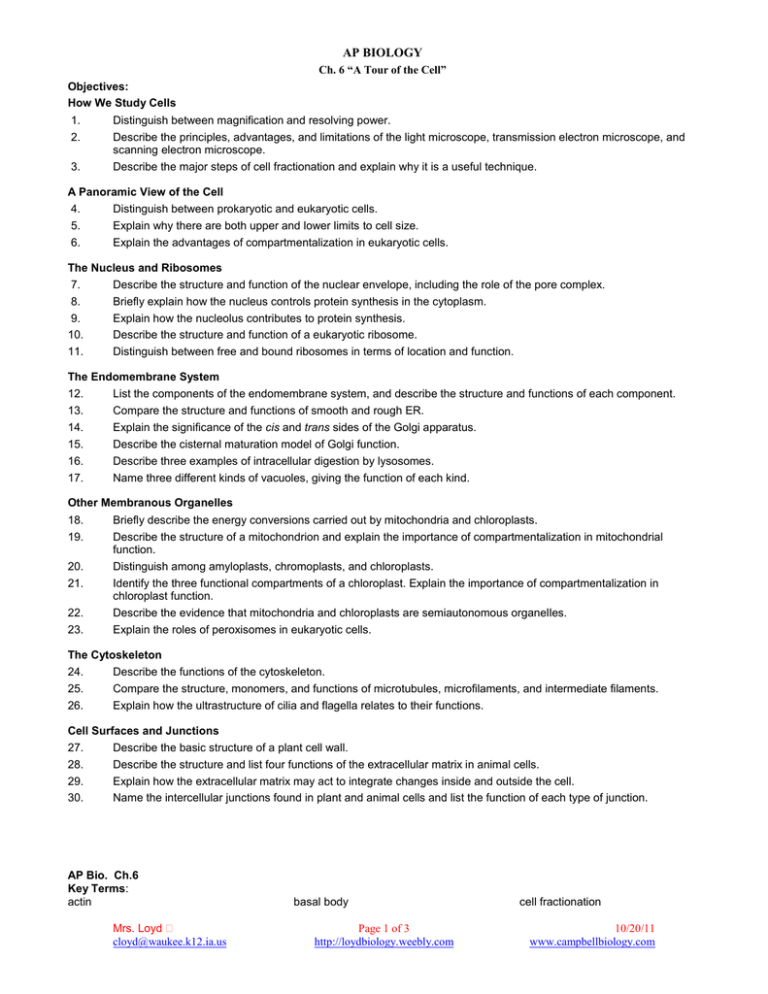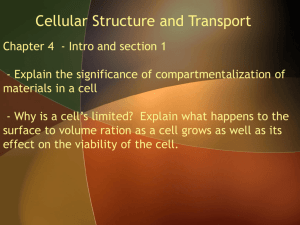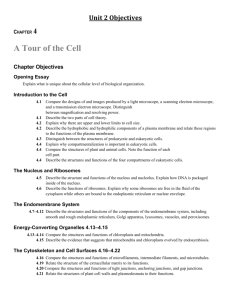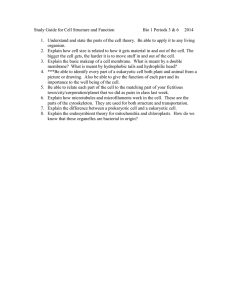AP BIOLOGY
advertisement

AP BIOLOGY Ch. 6 “A Tour of the Cell” Objectives: How We Study Cells 1. 2. 3. Distinguish between magnification and resolving power. Describe the principles, advantages, and limitations of the light microscope, transmission electron microscope, and scanning electron microscope. Describe the major steps of cell fractionation and explain why it is a useful technique. A Panoramic View of the Cell 4. 5. 6. Distinguish between prokaryotic and eukaryotic cells. Explain why there are both upper and lower limits to cell size. Explain the advantages of compartmentalization in eukaryotic cells. The Nucleus and Ribosomes 7. 8. 9. 10. 11. Describe the structure and function of the nuclear envelope, including the role of the pore complex. Briefly explain how the nucleus controls protein synthesis in the cytoplasm. Explain how the nucleolus contributes to protein synthesis. Describe the structure and function of a eukaryotic ribosome. Distinguish between free and bound ribosomes in terms of location and function. The Endomembrane System 12. 13. 14. 15. 16. 17. List the components of the endomembrane system, and describe the structure and functions of each component. Compare the structure and functions of smooth and rough ER. Explain the significance of the cis and trans sides of the Golgi apparatus. Describe the cisternal maturation model of Golgi function. Describe three examples of intracellular digestion by lysosomes. Name three different kinds of vacuoles, giving the function of each kind. Other Membranous Organelles 18. 19. 20. 21. 22. 23. Briefly describe the energy conversions carried out by mitochondria and chloroplasts. Describe the structure of a mitochondrion and explain the importance of compartmentalization in mitochondrial function. Distinguish among amyloplasts, chromoplasts, and chloroplasts. Identify the three functional compartments of a chloroplast. Explain the importance of compartmentalization in chloroplast function. Describe the evidence that mitochondria and chloroplasts are semiautonomous organelles. Explain the roles of peroxisomes in eukaryotic cells. The Cytoskeleton 24. 25. 26. Describe the functions of the cytoskeleton. Compare the structure, monomers, and functions of microtubules, microfilaments, and intermediate filaments. Explain how the ultrastructure of cilia and flagella relates to their functions. Cell Surfaces and Junctions 27. 28. 29. 30. Describe the basic structure of a plant cell wall. Describe the structure and list four functions of the extracellular matrix in animal cells. Explain how the extracellular matrix may act to integrate changes inside and outside the cell. Name the intercellular junctions found in plant and animal cells and list the function of each type of junction. AP Bio. Ch.6 Key Terms: actin Mrs. Loyd cloyd@waukee.k12.ia.us basal body Page 1 of 3 http://loydbiology.weebly.com cell fractionation 10/20/11 www.campbellbiology.com cell wall flagellum phagocytosis central vacuole food vacuole plasma membrane centriole gap junction plasmodesma centrosome glycoprotein plastid chloroplast Golgi apparatus primary cell wall chromatin granum prokaryotic cell chromosome integrin proteoglycan cilium intermediate filament pseudopodium collagen light microscope (LM) ribosome contractile vacuole lysosome rough ER crista microfilament scanning electron microscope (SEM) cytoplasm microtubule secondary cell wall cytoplasmic streaming middle lamella smooth ER cytoskeleton mitochondrial matrix stroma cytosol mitochondrion thylakoid desmosome myosin tight junction dynein nuclear envelope tonoplast electron microscope (EM) nuclear lamina transmission electron microscope (TEM) endomembrane system nucleoid transport vesicle endoplasmic reticulum (ER) nucleolus ultracentrifuge eukaryotic cell nucleus vesicle extracellular matrix (ECM) organelle fibronectin peroxisome Possible Essay Questions Ch. 6: Cell size and shape obj. 5: Upper and lower limit on cell size. obj. 6: Advantages of compartmentalization in eukaryotic cells obj. 19,21: Functional compartments of mitochondria and chloroplast, explain importance. Ch. 7: Describe how membrane structure is related to the transport of materials across a membrane. obj. 1,8,15,16,19,20 Mrs. Loyd cloyd@waukee.k12.ia.us Page 2 of 3 http://loydbiology.weebly.com 10/20/11 www.campbellbiology.com AP BIOLOGY Ch. 7 “Membrane Structure and Function” Objectives: Membrane Structure 1. Explain why phospholipids are amphipathic molecules. 2. Explain what freeze-fracture techniques reveal about the arrangement of proteins in membranes. 3. Describe the fluidity of the components of a cell membrane and explain how membrane fluidity is influenced by temperature and membrane composition. 4. Explain how cholesterol resists changes in membrane fluidity with temperature change. Traffic Across Membranes 5. 6. 7. 8. 9. 10. Distinguish between peripheral and integral membrane proteins. List six major functions of membrane proteins. Explain the role of membrane carbohydrates in cell-cell recognition. Explain how hydrophobic molecules cross cell membranes. Distinguish between channel proteins and carrier proteins. Define diffusion. Explain why diffusion is a spontaneous process. 11. Explain why a concentration gradient of a substance across a membrane represents potential energy. 12. Distinguish among hypertonic, hypotonic, and isotonic solutions. 13. Define osmosis and predict the direction of water movement based on differences in solute concentrations. 14. 15. 16. 17. 18. 19. 20. 21. Describe how living cells with and without cell walls regulate water balance. Explain how transport proteins facilitate diffusion. Distinguish among osmosis, facilitated diffusion, and active transport. Describe the two forces that combine to produce an electrochemical gradient. Explain how an electrogenic pump creates voltage across a membrane. Describe the process of cotransport. Explain how large molecules are transported across a cell membrane. Distinguish between pinocytosis and receptor-mediated endocytosis. KEY TERMS: amphipathic molecule aquaporin concentration gradient cotransport diffusion electrochemical gradient electrogenic pump endocytosis exocytosis facilitated diffusion flaccid fluid mosaic model gated channel glycolipid glycoprotein hypertonic hypotonic integral protein Mrs. Loyd cloyd@waukee.k12.ia.us ion channel isotonic ligand membrane potential osmoregulation osmosis passive transport peripheral protein phagocytosis pinocytosis plasmolysis proton pump receptor-mediated endocytosis selective permeability sodium-potassium pump tonicity transport protein turgid Page 3 of 3 http://loydbiology.weebly.com 10/20/11 www.campbellbiology.com







